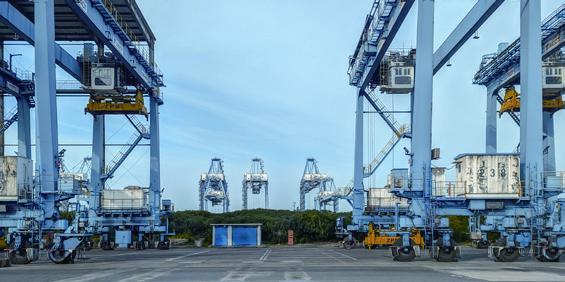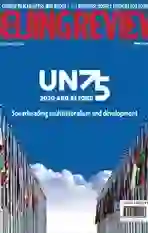Pumping Up Growth Together
2020-10-22ByLuYue&TianJilin
By Lu Yue & Tian Jilin
How many steps are needed before a Tesla car is ready for sale? According to the design and research and development process at the electric carmakers U.S. headquarters, first, the vehicle is fitted with its core part, the battery, which comes from Chinese manufacturer Contemporary Amperex Technology. Next workers assemble other parts at Teslas Gigafactory in Shanghai, after which it is handed over to sales channels such as retail stores.
Also, its offi cial website puts up information about the new car to disseminate the details and sales globally.
This is a typical example of dual circulation, which has become Chinas new design for economic development. It means the domestic market is developed as the mainstay of the economy while the domestic and foreign markets complement and reinforce each other. Since a key meeting of the Communist Party of China in July proposed this new growth pattern, it has become a buzzword in China.
The origin
The new pattern did not come out of the blue. It is a strategic policy adjustment against the backdrop of the situation at home and abroad at large.
The world economy is undergoing unprecedented changes with the spread of the novel coronavirus disease, China-U.S. trade frictions, the downturn in the global economy, and a shrinking market demand.
According to the International Monetary Fund, the global economy is expected to shrink by 4.9 percent in 2020. The instability in foreign supply chains and the prevalence of protectionism have created an extremely complex and severe external environment for China. It faces huge challenges from trade and investment protectionism. Therefore, for sustained and healthy growth, the Chinese economy must rely more on the domestic market.

In the course of trade frictions, the U.S. has been continuously trying to suppress Chinese hi-tech companies to weaken their competitiveness. The chip industry is an example.
For high-end chips, China depends on imports from the U.S. To cope with the restrictions imposed by the U.S. as well as other countries in the hi-tech field, China has turned to independent technological innovation to create alternatives.
Since reform and opening up started in 1978, China has actively participated in the division of labor in the global value chains and adopted an export-oriented strategy to achieve rapid economic development. However, excessive reliance on exports and investment also caused some side effects.
The dependence on foreign trade increased rapidly from 50 percent in 2003 to 64.24 percent in 2006. Domestic consumption was insuffi cient and its contribution to GDP growth was only 40 percent in 2007, compared with the average 60 percent in other economies in 2008. In addition, the lack of proprietary core technologies hindered industrial transformation and upgrading.
Since the global financial crisis of 2008, Chinas economic development strategy has gradually shifted to tapping both domestic and overseas resources and markets. Its dependence on foreign trade was reduced to 31.8 percent in 2019. However, it is still high compared with other major economies, for example Japan, which recorded 28 percent. The ratio of final consumption to GDP has increased year by year, remaining above 50 percent since 2012.
Since dual circulation has proved its merit in recent years, it is the best choice in the current situation.
The history
The U.S. too has gone through this process in three stages. During 1800-70, it exported cheap raw materials and imported expensive industrial products. This became the main force driving the development of the U.S. economy.
When the U.S. industrialization made great strides during the Second Industrial Revolution and its products were welcomed in the international market, external circulation played a prominent role in boosting the economy, reaching its historical peak around 1913.
After World War I, the Great Depression and World War II, the U.S. began mass production to promote industrial upgrading and invested heavily in expanding consumer spending. These efforts propelled the domestic circulation both from the supply and demand sides and fi nally reshaped its international circulation, laying foundation for the strong U.S. economic growth.
After World War II, Japan embarked on export-led growth, which produced good results. However, in the 1980s, trade frictions between Japan and the U.S. escalated. The U.S. imposed sanctions on Japan in areas such as automobiles, semiconductors, telecommunications and fi nance. Due to the excessive reliance on the U.S. market, Japan was forced to compromise and voluntarily restrict exports.
In response, Japan shifted its policy priority from expanding trade to supporting technological innovation, and adopted a new economic pattern where the internal circulation played a leading role, supplemented by external circulation.
It can be seen from the history of developed countries such as the U.S. and Japan that after an economy reaches a certain stage in development, internal circulation will overtake external circulation as the primary source of growth momentum.
There have been many misunderstandings as some people interpret the domestic circulation simply as transforming exports into domestic sales and think China may therefore close its doors to the outside world. However, in reality, this is not the case.
On July 21, at a symposium with entrepreneurs in Beijing, President Xi Jinping answered these doubts. He stressed the need to pool resources and concentrate on managing domestic affairs well, utilizing the advantage of the huge domestic market so that a new development pattern is created. In this pattern, while the potential of the domestic market is utilized to the full extent, the domestic and foreign markets will boost each other.
Therefore the new pattern is not a halt to international circulation; it supplements and upgrades it. China has one of the worlds largest markets and a complete industrial system. Meanwhile, many industries in China rely on imports for raw materials, components and technology. China and the world economy are inseparable.
The future
The dual circulation pattern is an economic globalization strategy based on domestic demand with opening up as an essential part. It means not only to open up to the outside world, but also to the domestic market.
A strong domestic market needs to be built to break institutional obstacles. It means, people-wise, government agencies delegating more power to the people for them to have a greater say in economic activities.
Enterprise-wise, it means making laws and regulations to equally protect the property rights and autonomy of both state-owned and private enterprises, ensuring equal competition.
Region-wise, it means breaking down administrative divisions, for instance in the Guangdong-Hong Kong-Macao Greater Bay Area, the Beijing-Tianjin-Hebei region, the Yangtze River Delta, and the ChengduChongqing city cluster, and build regional industrial chains.
Innovative solutions based on artificial intelligence, the Internet of Things, cloud computing, big data, network security and integrated circuits technologies should be introduced to accelerate replacement of old machines and promote upgrading of traditional industries.
Efforts should be made to step up the construction of new infrastructure including 5G and promote the use of new-energy vehicles. It is essential to cultivate innovation chains led by emerging industries and strengthen them through facilitating the consolidation of enterprises involved.
In addition, a focus should be put on the demand side through reform of the national income distribution system. While implementing the minimum wage regime, its crucial to impose high progressive tax on high-income earners. Enterprises should be encouraged to distribute a certain proportion of profi ts among employees. Public investment in housing, education and medical care facilities should be increased to alleviate the expenditure burden and future worries of the middle- and lowincome groups, and increase their propensity to consume.
At the same time, more policies should be rolled out to expand Chinas participation in bilateral, regional and global cooperation, relax market access, protect the legitimate rights and interests of foreign investors, and create a market environment in which domestic and foreign companies are treated equally. Other signifi cant measures should include building platforms to facilitate the urbanization process and introducing global talents and technologies.
Enterprises should be more active in undertaking outsourcing, participating in joint ventures or mergers and acquisitions of foreign companies, and implementing localization strategies in host nations of their investment projects. They should establish an extensive exchange network, using global resources to innovate development approaches and enhance their competitiveness.
